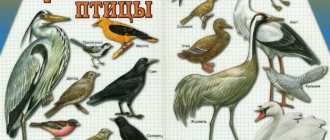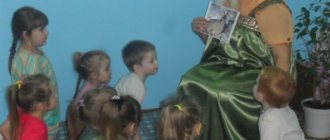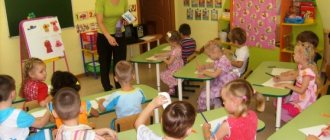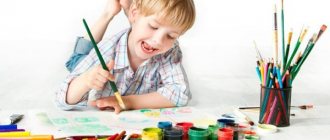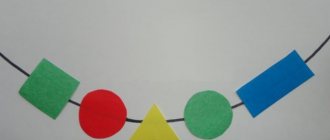Summary of GCD for drawing “Bear” in the middle group
Advanced training course for 340 rubles!
Emotional burnout of teachers. Prevention and ways to overcome
Municipal state preschool educational institution "Kindergarten No. 25"
educational activities in the middle group.
Theme of the week
: “Who is preparing for winter?”
Developed and conducted by teacher Mezentseva O.I.
Goals:
Continue to learn to master drawing examples (round and oval shapes), paint over them in a circular motion, carefully, without going beyond the contour.
Be able to convey the characteristic features of an animal (bear), observing proportions.
Fix the shape, color, size.
Foster independence and accuracy in work.
Blue cardboard (according to the number of children), paints, brushes, cups of water; templates; example of a teacher; video letter from a bear.
Preliminary work: a surprise moment at the beginning of the week a toy / gnome
/. The gnome is rearranged throughout the group during the week, unnoticed by the children, and the teacher draws the attention of the children to this.
Preliminary work:
viewing the album “Winter in the Forest”, conversation “How animals prepare for winter”, reading the poem “Why does a bear sleep in winter?” V. Orlova.
Preview:
Municipal autonomous educational institution
"Kindergarten No. 21 "Alenka" Guryevsk
Summary of a drawing lesson in the younger group.
Educator: Lukash V.A.
Demonstration material: sample of a finished drawing of a bear; outline of a bear on a landscape sheet; plush bear toy
Handout: landscape sheets with a finished outline of a bear; pin tool on a stand, cotton swabs, black and brown gouache, napkins;
There is a knock on the door, the teacher comes in and brings in a large plush toy “Bear” (the bear roars)
Educator: What happened? Dear bear, why aren’t you sleeping?
Little Bear: I was about to go to bed in my den, but suddenly I remembered that I had no friends and I felt very sad.
Guys, who came to us?
Children look at the bear.
Don’t be sad, bear, we will help you find friends, and you can sleep peacefully in your den until spring. See how children can draw.
I have a friend in my hands for our bear (the teacher shows the finished sample), you will have many equally beautiful and kind friends (addressing the children). Go to your desks. Do you see? There are painted bears on the tables, but the drawings are not finished. Let's make our bears fluffy? Today we will paint not with a brush, but with foam rubber on a stick, it will work in a special way, jump up and down. Take your foam sticks and try pressing without paint.
The teacher shows each child the movements of the brush up and down, the children independently repeat the movements on the sheet of paper.
Educator: Well done, you are doing everything right! Now put brown paint on a foam stick and begin to paint along the contour.
The teacher and each child trace the outline of the bear using the poking method, then use the same movements to paint over the entire bear.
Educator: What beautiful and fluffy bears you made! We performed them using a special technique: it is called “Poking”. We're a little tired, let's warm up while our bear friends dry off.
The warm-up “We see a house on the mountain!”
- Well done guys, now look at your cubs, what else did we forget to draw? What are the cubs missing?
Children: Eyes, noses, mouth.
Educator: Well done! Look, guys, can we draw a mouth and nose with our foam stick?
Children: No, she is big, but her mouth and nose are small.
Educator: That's right, the eyes and mouth need to be drawn with something smaller. To draw the eyes, mouth and nose, we will take a cotton swab and dip it in black paint.
The teacher shows in his drawing. At the end of the work, children place their brushes on stands and wipe their hands with a napkin.
Educator: Look, bear, how many friends you have now! The guys tried very hard to help you (children show their drawings)
The teacher thanks the children on behalf of the bear.
Now you can sleep peacefully in your den
Educator: Thank you. Bear, who came to visit the guys! Now it's time for you to go into the forest. Goodbye!
Children say goodbye to the bear.
Summary of a lesson in the middle group on drawing animals in unconventional ways
Svetlana Danilova
Summary of a lesson in the middle group on drawing animals in unconventional ways
Municipal budgetary preschool educational institution general developmental kindergarten No. 37 “Fairy Tale”
Tuapse municipality Tuapse district
Summary of direct educational activities for children of the middle group in the educational field “Artistic Creativity”
(
drawing in non-traditional ways ) on the topic
“Guys visiting the bear cubs”
Performer: Danilova S. A.
Tasks. Teach children to draw animals using the poking method . Strengthen the ability to paint with a brush in different ways . Develop the ability to independently choose the color scheme for an image; Ability to properly use a brush and napkin. Cultivate a desire to help. Develop an imaginative interest in the visual arts.
Preliminary work. Looking at illustrations of animals . Reading the fairy tale “The Three Bears”
.
Material. a landscape sheet with drawn outline of a bear in different poses; 2 brushes (hard and thin, equipment for painting . Two samples: on one, an outline of a bear; on the other, a bear drawn using the poking method . Bear mask, toy bears.
On the topic: methodological developments, presentations and notes
Summary of an open lesson on drawing in a non-traditional way (poke drawing + emerging drawing) middle group “Animals of our zoo.” compiled by Kuznetsova Svetlana Vladimirovna Put.
Program content: Introduce children to a new type of non-traditional drawing technique “imprint, imprint with leaves” Create conditions for artistic experimentation: show the possibility.
Introducing middle preschool children to a new, non-traditional drawing technique (drawing with foam rubber).
Goal: To introduce children to a new technique for obtaining images: prints with half an apple. Tasks:1. Give children knowledge about the method of applying paint to the cut of an apple; press half of the apple against the apple.
Lesson summary using an unconventional method of drawing (pointillism).
Teaching children how to draw a bear with a simple pencil and the poking method, conveying the size and proportions of body parts.
Technological maps for the execution of drawings
When depicting animals, it is very important to clearly formulate for children the order in which the contours of the drawing should be completed.
Table: description of the procedure for working on animalistic topics for the middle group
| Subject | Operating procedure |
| "Bunny" |
|
| "Hedgehog" |
|
| "Little Bear" |
|
| "Giraffe" |
|
| "Squirrel" |
|
| "Wolf" |
|
| "Kid" |
|
Photo gallery: animal drawing schemes
The drawing of a kid can be supplemented with applicative elements: a sun made of plasticine, grass made of colored paper
When drawing hedgehog needles, it is important to draw children’s attention to the unidirectionality of the “layers” of needles
In the drawing of a squirrel, children complete some elements from memory, for example, the shape of the ears, claws
To make the color of a giraffe richer, you can use wax crayons of suitable colors. To color a polar bear, you can use semolina, and a brown bear, buckwheat.
The hare drawing is based on three geometric shapes: two ovals and a circle
To learn how to convey the elegance of the curves of a wolf’s body, children need to repeat the contours of a finished drawing several times, that is, trace a stencil with a pencil
Video: master class on drawing a cat
Video: master class on drawing a hedgehog
Goal: to consolidate the ability to distinguish diminutive suffixes of nouns in the speech of adults when naming objects and phenomena.
Tasks:
• train children in the ability to distinguish by ear sounds pronounced in a high and low voice;
• learn to distinguish between large and small objects when answering and correlate them with a certain morphological indicator in the speech of adults (table - little table, spoon - spoon); • learn to imitate the voices of “big” and “small” (sounds, syllables, simple words). Equipment:
two toys - a soft toy bear and a small plastic mouse (it can be replaced with a figurine sculpted from plasticine) - the sizes of these toy animals must differ from each other in a proportion of at least 1: 3, a toy den (a large paper box with a side slot, lined with cotton wool on top), a set of children's doll furniture and dishes, Christmas tree or pine branches, a table, chairs.
Venue:
games room.
Progress of the lesson
Invite the children to a table on which a den has been previously prepared: an inverted paper shoe box with a side slit (hole), lined with cotton wool on top. Around the den there are fir trees (spruce branches) in the forest. There is a mouse next to the den. She hides in the fir trees. Ask one child to show where the mouse hid. Ask another child how the mouse squeaks (“pee-pee-pee” or “e-e-e”). Then tell the children a story about a mouse: “Once upon a time there was a mouse. She was small, small. Here it is! (Gesture demonstrating how small the mouse is.) She did not have her own house. She ran everywhere and looked for some bread. But in winter it snowed. (Pointing gesture towards the snow.) And the little mouse had nothing to eat. Around (gesture around the mouse) there is only snow and Christmas trees, and not a single piece of bread. The mouse is very sick! We will take pity on the mouse and pet it. (Children pet the mouse.) We need to help the mouse and find a house for it. Look where the mouse can hide? Shall we hide the mouse here? (Gesture towards the entrance to the den, prompting the children to the correct answer.) (“That way!”) The children hide the mouse in the hole on the side of the den box.) The mouse hid! And it keeps snowing and snowing!” Get up from your desk, take a few cotton balls out of your pocket and blow them down from your palm. Cotton pieces fall down onto the table: there is more and more snow. Children get up from the table and also begin to blow over the table, blowing the cotton wool off the adult’s hand. Snow is falling down. Then ask the children: “Who lives in this house?” (“Mouse.”) Invite the children to see how the mouse lives in its house. Pick up the box and exclaim: “Oh! There's someone here! Who is this?" The children see that there are two toys in the house: a mouse and a bear, which, having taken refuge, is sleeping on a small sofa. (“Mouse and bear.”) “Who sleeps on the sofa? (“Bear.”) Where is the mouse?” (The child must show that the mouse is “hidden” under the sofa.) (“Here.”) The mouse and the bear are placed on the table. Once again, draw the children’s attention to the fact that the bear is big and the mouse is small. The game “Big and Small” is carried out in the form of a conversation with children. Each child must answer the questions “Where is the big one?” and “Is it big or small?” For example, ask: “Where is the big table? And the table: is it big or small? The game is played on object material placed inside the house (this can be a spoon and a spoon, a bowl and a bowl, a pillow and a cushion). It is important that all pairs of words change according to a single word-formation model - using the suffixal method of word formation (-ochk-, -echk-). Then the game “Whose Voice?” is played. Keep both toys behind your back so that children cannot see them. For this game, the child must recognize the voice of the toy and choose the item in the house that she asks for. This request should not contain a direct indication of the object, i.e. the bear (in the voice of an adult) should not say to the child “Give me my bed!” Speech instruction
can be formulated according to the following model: “Y-y-y. I want to sleep! I want to sleep! Where should I go? Where should I lie down? Vanya, help me! The named child must recognize the toy by its voice and give the bear its bed. At the end of the lesson, the children, together with an adult choir, speak in the voices of a mouse and a bear. The mouse squeaks: “E-and-and!” The bear howls: “Y-y-y!”
On the topic: methodological developments, presentations and notes
in this educational field of Artistic creativity, section: Drawing, non-traditional drawing technology and information technology are used.
- Consolidate knowledge of A. Barto’s poem “Ball”; - Learn to pronounce together the words of the game “My cheerful, ringing ball”; - Continue learning to paint over the outline of a drawing using a piece of foam sponge;-.
The presented material can be useful to teachers in developing creative abilities in preschoolers through unconventional drawing, developing aesthetic perception, and a sense of composition.
Goal: - To consolidate knowledge of A. Barto’s poem “Ball”; - To learn to pronounce together the words of the game “My cheerful, ringing ball”; - To continue to learn how to paint over the outline of a drawing with help.
Introducing children to unconventional drawing techniques: crumpled paper and fingers.
This lesson is conducted with children of the 2nd junior group.
Source

